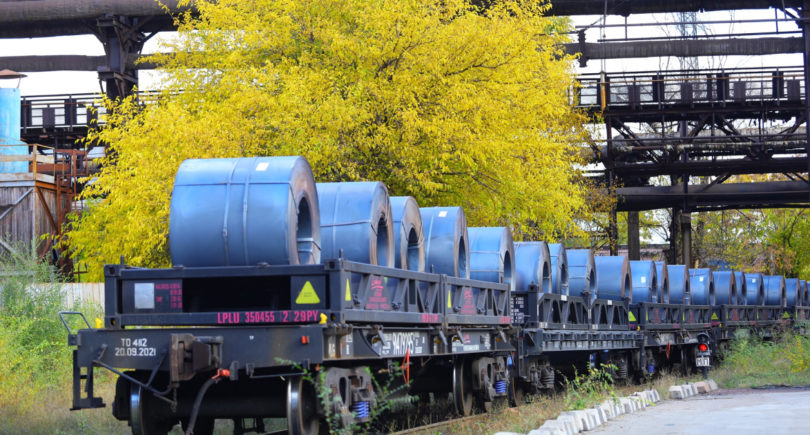
Unblocking sea ports for iron&steel products will ensure growth of foreign exchange earnings and stabilization of the exchange rate
Iron ore and steel products export was and remains a significant source of filling the state budget and foreign exchange earnings for the country. However, a number of difficulties in logistics and market factors led to its decline. This became one of the reasons for the sharp devaluation of the hryvnia in recent weeks. Restoration of exports of iron&steel products is an important factor in ensuring macroeconomic stability.
Past achievements
According to the results of 2021, Ukrainian iron&steel companies provided about $22 billion or a third of exports of goods from Ukraine.
Today, such consumers of steel products as Turkey (the average monthly export decreased by more than 14 times), China, the UK, the USA, and the MENA countries are virtually inaccessible to Ukraine.
The situation is the same for iron ore: the main consumer of Ukrainian iron ore last year was China with a share of 43% in exports. Today, this consumer is absent, as export from Ukraine is possible only by rail. The same is for other Asian countries, Turkey and MENA, which accounted for up to 10%.
Ore logistics
Traditional ways of exporting iron ore and steel products are through sea ports. According to GMK Center estimates, more than 60% of exports were provided by sea. Two ports were key in this respect – Izmail and Pivdenny. From Izmail the goods went up the Danube to European consumers, and from Pivdennyi – to China and other customers.
Wartime
Now, during the war, the inaccessibility of ports sharply limited the volume of exports of iron ore and steel products. Although Ukraine was able to increase its supply to the EU by rail, partially replacing Russian products there, but there is a catastrophic lack of available capacity at the western border crossings. Therefore, due to the blockade of ports, Ukraine loses more than 60% of the potential export of iron&steel products and, accordingly, does not receive up to 20% of foreign exchange earnings, which negatively affects the exchange rate.
“The decrease in production in the industry, as well as exports, is very unfortunate for the Ukrainian economy, considering that steel industry is the traditional basis for exports and foreign exchange earnings to the country – in general, it has 30% here. In the pre-war period, the industry was a leader in terms of investments – every 4th dollar spent on modernization in Ukraine was in this direction,” says the president of UUIE Anatoly Kinakh.
There were, of course, attempts to deliver to China through the seaports of neighboring countries – Poland (Swinoujscie) and Romania (Constanta). But it was too expensive (traffic jams of railcars at the border and direct bans on exports through individual border crossings), so the supply remained trial.
In the future, the implementation of the grain agreement has the potential to relieve the situation at the border. The first ships with grain from Odesa have already left. But a 70% increase in rail tariffs makes rail supplies to Europe impractical. This increased transport costs up to 4 times.
“If we do not intervene in the situation, then, first of all, we will lose the European market, where we have already successfully replaced Russia. Now exporting companies from Brazil, Australia, and South Africa come there. Secondly, the loss of jobs and export revenues in the current war situation will place an incredible additional burden on the budget, which already has a deficit of $5 billion every month. The government needs to discuss together with representatives of the industry and experts how to increase the volume of iron ore mining and steel smelting and their export”, – according to the Ukrainian Union of Industrialists and Entrepreneurs (UUIE).
Therefore, it is very important for the government, together with representatives of steel industry to work out mechanisms to compensate for the losses caused by the sector. This is the reduction of the tax burden, in particular the rental rates for mining, freight rates, ensuring the absence of manual interference in the work of the automatic VAT refund system for exporters, solving the problems of export logistics – purposeful work with the participation of international structures to unblock sea ports for the export of iron ore and steel.
“Thus, these steps will provide another powerful source of currency inflow to the country, which will contribute to the stabilization of the national currency rate. We consider UAH 36.6-37 per dollar to be the objective exchange rate under these conditions, the rest is the market’s response to export difficulties and such innovations from the government as the possibility of an additional 10% tax on imports,” added Anatoly Kinakh.
Not an easy way out
Unblocking the ports for the export of steel cargoes would be the best solution to stabilize the exchange rate. For example, one ship of iron ore provides over $14 million in export revenue – slightly more than a ship of grain, and a ship of steel provides $16.5 million in export revenue. This could increase the country’s foreign exchange earnings by hundreds of millions of dollars per month.
“Our current bottleneck on the western border is unable to cope with the flow of export cargo, railcars are standing for at least 2-3 weeks. Therefore, I believe that any expansion of the agreement on transportation from ports, including for metalsl cargoes, and previously 70% of export cargoes were exported in this way, will be a boon,” the economist emphasizes Danylo Monin.
We see that the issue of stabilizing the situation on the foreign exchange market is extremely acute. Today, a document on the introduction of a 10% import duty on all imports is being developed. This, according to the government, should reduce the demand for foreign exchange for imports. But there are other ways to stimulate exports.
“Against the background of lower prices for steel and iron ore, the export turnover of steel companies will decrease somewhat, but even this level, with the growth of exports, will help support the exchange rate of the national currency,” says Volodymyr Panchenko, Doctor of Economic Sciences, partner of KSP Strategies
It is critical to gain access to markets other than Europe. For example, it would be possible to supply pipes to the largest markets – the USA and the Middle East. Ukrainian diplomacy succeeded when the 25% import duty on steel from Ukraine was canceled in the US. But in fact, no one can take advantage of this – the export routes are closed.
This is also the growth of the economy not only due to the increase in output, but also due to the normalization of port operations. It’s not an easy path, but the game is worth the candles. The benefits are obvious.





